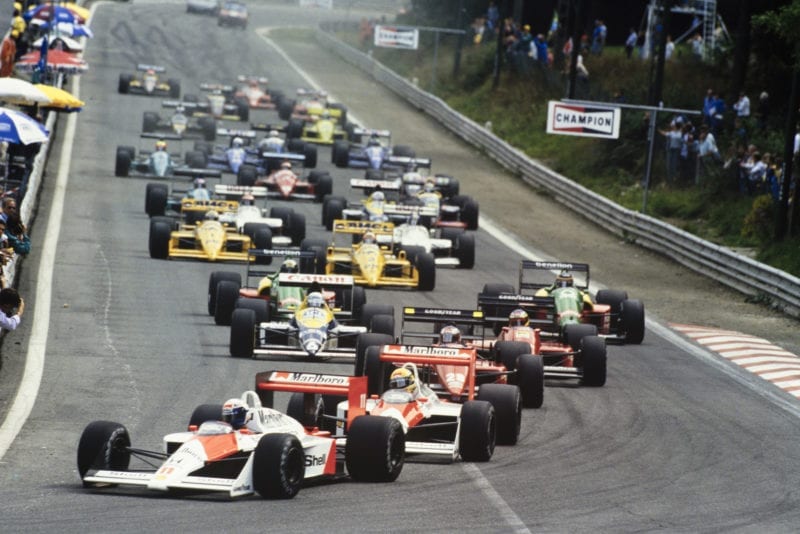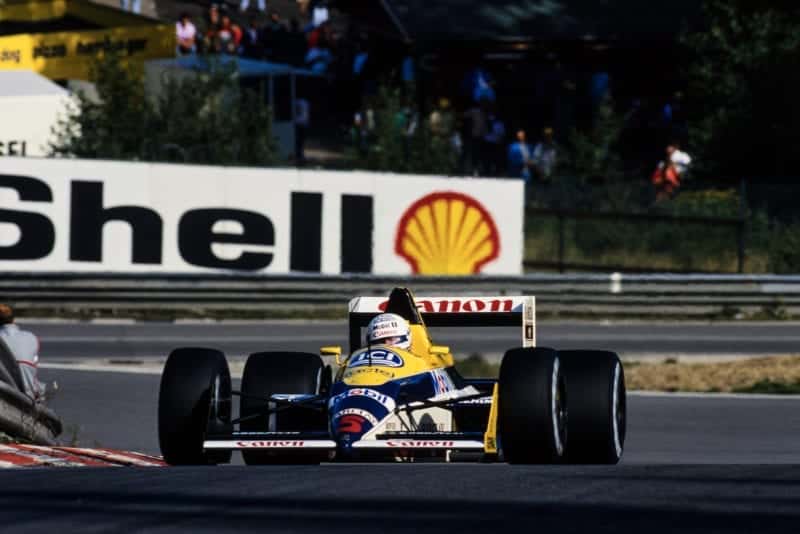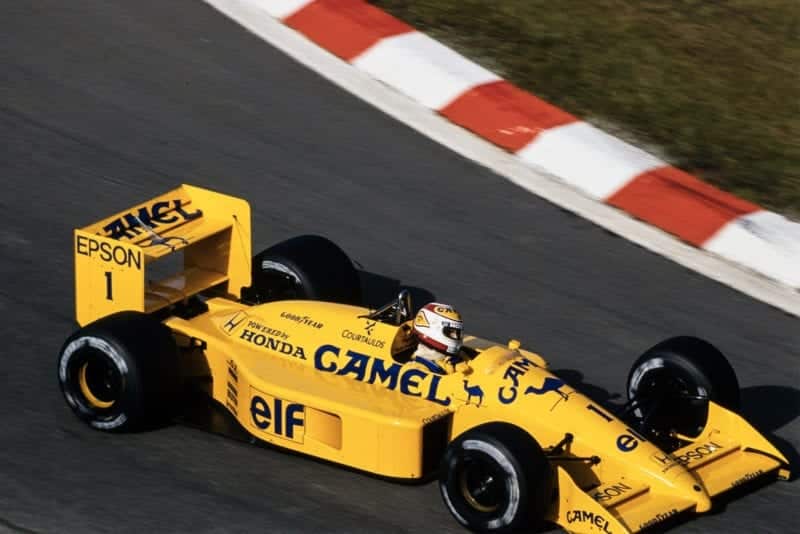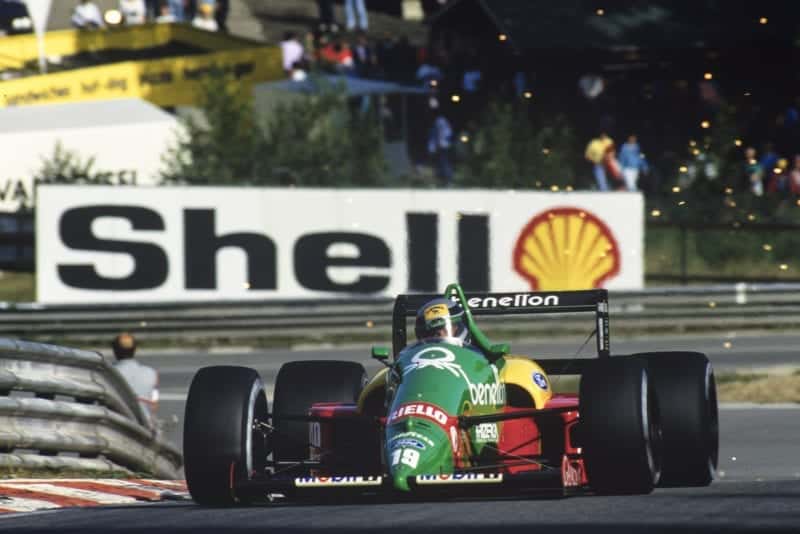Formula One: 1988 Belgian GP
The best of everything
Francorchamps, August 28
If there is a better driver than Ayrton . . . No, wait a minute, I said that last month. Let’s start again. If there is a better circuit used for Formula One racing today, I’d like to see it. The Nationale Circuit de Francorchamps with its 6.94 kilometres (4.3 miles) of impressive descents and climbs and tight first-gear hairpin in the south-east corner of Belgium just has to be the best there is.
I first saw the Francorchamps circuit from the platform of a racing sidecar outfit in 1948, almost exactly 40 years ago to the day, and I thought it was the ultimate Grand Prix road circuit. Now, 40 years later, even though it is half its original length it is still the best, and a drive round it, even in a Eurobox, produced old-fashioned simple exclamations like “Cor!” “Ooh!” “Kee-ryst!” “Wow!”
Put Ayrton Senna on the circuit in a McLaren MP4/4-Honda, in perfect weather conditions, and you can sit back and watch and listen with the satisfaction of experiencing David and Igor Oistrakh giving the sort of violin recital that makes the “tingles” run down the spine of a true music lover. I am talking of standing on the side of the circuit at Eau Rouge bridge, for example, and watching the red and white car visibly accelerating downhill towards you, feeling the sound waves from the engine as the car sweeps by with just the barest lift of the throttle and then powers up the steep “Raidillo

The McLaren team-mates lead the start of the 1988 Belgian Grand Prix
Motorsport Images
n” and away over the brow. During the race Senna had such a lead that you could listen to his Honda engine on full song almost to the end of the long climb to the “chicane” at Les Combos before the next car came by.
It was Grand Prix at its best, and that “next car” was Senna’s team-mate Alain Prost in a similar car. Double joy! Of course, this means being out in the sunshine and being slightly more deaf than usual at the end of the race, not sealed away inside a glass viewing box or sitting at home in front of the television. There were only 65,000 people able to experience what I write about, plus the two or three thousand like myself who are paid to enjoy such things.
This is why I returned home full of enthusiasm for Grand Prix racing as it really is, to find all my friends who could only watch it on television yawning and saying: “What a bore”. If I had to sit at home and watch what appear to be slow-moving model cars to a muted background of sound that bears no relation to reality, over-ridden by the excited chattering of dear old Muddly Walker, I would probably find it all a bore too. There is no real substitute for “being there”, but not everyone is lucky enough to have the opportunity. As friends have been saying for nearly 50 years now, “It’s alright for you…”
Yes, it is alright for me, and while we have circuits like Spa-Francorchamps and cars like McLaren-Hondas, it’s alright for Formula One. Grand Prix racing is alive and well. Behind the two McLarens there was some good racing going on, some reputations were being enhanced and some new ones made. Taking part in a race at Francorchamps is not a matter of “racing wheel-to-wheel” in an unruly scrabble such as happens at Brands Hatch; it is a matter of high-speed precision driving, accuracy and judgement, in a car that is perfectly “tuned” for the requirements.
The winner’s average speed for the 43 laps was 203.447 kph (over 126 mph) and this included coming almost to a stop at the hairpin on each lap. Scrabbling round the hairpin in first-gear is not that important, the real test is taking the high-speed corners at high speed, like the long three-part left-hand sweep downhill in the middle of the circuit. Race lap times were just over two minutes a lap, during which there is little time for relaxation and some idea of Senna’s ability can be seen by a look at his individual lap times, provided by the Longines-Olivetti electronic timing apparatus, which Olivetti kindly provides for those jounalists who are interested. Lap 12: 2.01.772 Lap 13: 2.01.891 Lap 14:2.01.805 Lap 15: 2.01.665 Lap 16:2.01.711 Lap 17: 2.01.792 Lap 18: 2.01.061 Lap 19: 2.01.341 Lap 20: 2.01.373.

Martin Brundle in the Williams, replacing Nigel Mansell after he was medically ruled out from racing
Motorsport Images
During this remarkable series of laps Senna recorded his fastest of the race on lap 18, and lapped the Coloni on lap 19. He then caught up with the two Zakspeeds and in lapping them his times fluctuated by 1.9 seconds, and all at an average speed higher than most of us have ever driven at for more than a fleeting moment. His variation during those nine consecutive laps was a mere 0.83 seconds, from fastest to slowest; just try measuring eight-tenths of second and you will get some idea of the remarkable precision and judgement of the Brazilian driver.
His race was not 100% perfection, for his start was not up to Villeneuve standards, and Prost got the drop on him from the second position on the grid and came down to the Eau Rouge bridge in the lead. Even Prost knew that the situation was temporary, a lap at the most, but by the time he reached the end of the long uphill straight to Les Combes he knew his lead was meaningless.
Between warm-up and the race Prost had altered his aerodynamic adjustments to provide more cornering power at the cost of a very minimal loss of top speed, but that loss was visibly too much by the time the two McLarens were half-way round the opening lap, so he graciously waved his team-mate by into the lead. Even down the descent and through the high-speed swerves his downforce advantage was not significant and by the end of the opening lap it was all over for Prost as regards finishing first.
During Senna’s demonstation of the Art of High Speed Driving he demonstrated on four occasions his incredible superiority over Prost under racing conditions. Lapping slower cars is a part of the Grand Prix scene, like “traffic” during qualifying sessions, and fortunately the Spa-Francorchamps circuit is wide and clear so that overtaking causes few problems. Although Senna was away on his own there was some good scrapping going on right through the field; the two Zakspeeds of Schneider and Ghinzani were in close company, with Johansson and Palmer racing each other ahead of them. Then further up the field were Alliot and Streiff, and nearer the front Cheever and Brundle. Senna came up behind each of these “pairs” in turn and effectively passed them two at a time. His slowest lap during these passing manoeuvres was 2min 05.968sec, which was on lap 39 with the end of the race in sight and he was already “rolling it back”. During the height of his lapping his slowest lap had been 2rnin 03.609sec.
All this time Prost had been following neatly and tidily in second place, but he tended to overtake slower cars one at a time, rather than in pairs, and though his lap times did not vary much more than Senna’s he was 30 seconds behind by the end of the race. In those far-off days of 1955 when Fangio and Moss used to give similar demonstrations of total superiority with the Mercedes-Benz W169 cars, they usually finished much closer after racing in similar conditions, lapping most of the field. The English driver admitted that it took everything he’d got to stay with Fangio when it came to lapping slower cars, but it was a point of honour not to get left behind!

Nelson Piquet’s Lotus
Motorsport Images
That then was the Senna/Prost, McLaren/ Honda show and it was well up to the expected standard, but there was a lot more than that going on.
Before the meeting began the tabloid press had a field day with Nigel Mansell succumbing to illness and having to withdraw, and Frank Williams inviting Martin Brundle to “stand in”. Now Brundle came on the scene in Formula One a year or two ago and though showing promise did not make much progress. His term with Tyrrell while the team tried to cope with Renault turbo engines was a disaster, and when Tyrrell opted out of turbo racing to run at the back with Cosworth power in 1987 Brundle went to Zakspeed in desperation. It was an even worse disaster, so he wisely pulled out of Formula One for 1988 and joined the Jaguar sports-car team, where he not only had the chance to drive a winning car but made the most of the opportunity. When Frank Williams gave him the chance retake Mansell’s place in the Belgian Grand Prix he did not hesitate, and Tom Walkinshaw and Jaguar kindly released him from his contract. By sheer chance (one hopes!) he had been doing a lot of test-driving for the Williams team because Patrese and Mansell “were otherwise engaged” said the Williams PR department.
Brundle was all keyed up and ready for a brief return to Formula One, and he came through with flying colours. In the first qualifying session he was 12th fastest, and on Saturday in the pouring rain he actually topped the list. It was not that significant, for most of the front-runners merely went out to look at the conditions and weigh up the situation, and Prost did not even bother to go out. Nonetheless Brundle could have slopped around moaning that it was hopeless, but he didn’t, he got on with the job.
From his 12th position on the starting grid he kept his place in the opening lap and then had the two “likely lads” in the turquoise Leyton House March-Judd cars hot on his tail. It was not until lap 12 that Mauricio Gugelmin got by, and Ivan Capelli one lap later. It seemed to Brundle that maybe he had gone a bit too fast too soon and his tyres were “going off “, so once the March cars had got by he eased off slightly, content to keep them in sight, rather than get involved in an unruly scrap. Unbeknown to Brundle his trouble was not overheated tyres but a very slow puncture in the right rear one, the very gradual loss of air affecting the handling in an insidious manner. He finished in ninth place, one lap behind the leader, with very little air left in the tyre and during the last ten or fifteen laps it was very obvious what the trouble was, but there was little point in making a stop for a new tyre.
Taken all-round, Martin Brundle’s return, albeit brief, to Formula One did him more good than all his previous experience and it was a genuine case of “in at the deep end”.

Ayrton Senna leading
A driver whose style and speed has been long admired by those who can appreciate such things is the Belgian Thierry Boutsen. Not only did the Francorchamps circuit do full justice to his driving prowess, but he did more than full justice to the circuit and to his Benetton B188. This is another combination of car and driver that is always a joy to watch, no matter where, and his smooth, unruffled and polished style in the Cosworth DFR-powered Rory Byrne-designed car put him well ahead of any of the other non-turbo 31/2-litre cars.
That he finished in third place was partially due to the failure of the Ferraris, but nonetheless it was more than deserved. Not a simple afternoon promenade as it may have looked to distant viewers, but continuous driving to the maximum to finish just under one minute behind Senna, which amounted to just over one second-a-lap loss throughout the race. He reeled off a series of as many as six laps in succession with a variation of half a second.
In the opening two laps Boutsen lay fifth, with Alboreto and Berger ahead of him, but on lap three Berger’s electrics went awry and he stopped at the pits, leaving Alboreto to hold third place. This the Italian did, though unable to stay with the two McLarens, until there was a big cloud of blue smoke from the Ferrari engine as he plunged down to the Eau Rouge bridge. As the Ferrari disappeared over the brown of the “Raidillon” the smoke got worse, and before the end of the lap there was a bang and oil everywhere and the yellow flags and the oil flags were waving frantically. As Boutsen inherited third place the Benetton tried to get away from him on the oil and afterwards he quietly mentioned that it had been “a big moment”. His calm demeanour was as smooth as ever, but in his eyes you could read a quiet satisfaction that he had been master of the situation. More deeply could be seen the satisfaction of finishing a brilliant third in his home Grand Prix, on his home circuit.
All weekend the Ferrari team had seemed like a ship without a Captain, for Enzo Ferrari had died just two weeks before. Not that the “old man” had really been in control in the last few months, but he was there in Maranello, and that meant everyone in the racing team felt a sense of responsibility to him. Now he was gone. The team was getting on with the job but you could not help sensing that they were all aware that there was no-one at Maranello who was going to want to know, why? Throughout practice and qualifying the cars had been fast on maximum speed, if not so fast for the full lap and Berger and Alboreto had lined-up third and fourth on the grid. After Berger’s pit stop to have various electrical components changed he rejoined the race in last position, set a fastest lap for the race on lap 10 and expired for good two laps later. The official word was “electronics” which meant an untraceable electrical malfunction.
For a team in only its second season of current Formula One racing, the Leyton House March Team has been impressive. Running a single car entry for Ivan Capelli last year, using Cosworth DFZ power it needed watching. This season, with Judd V8 power and running two cars it has been very much “there” and the second driver Mauricio Gugelmin has begun to look as if he has always been in Formula One, instead of being two-thirds through his first season.
While we have Prost and Senna as a homogenous pair at the top of the tree, we have Capelli and Gugelmin as a similarly well-matched and talented pair half-way up the tree. While those at the top can only eventually descend, those half-way up can go on climbing. The Judd V8 has not been a roaring success in the Williams FW12, and is a total disaster in the Ligier JS31, but the same engine in Adrian Newey’s March 881 design has been unobtrusively successful.

Alessandro Nannini in the Benetton
Motorsport Images
Very early in the race Gugelmin’s car had its clutch-operating mechanism go on the blink so he did all his changing without the clutch. No real problem with a modern Formula One gearbox, but it did call for faultless changes and on one occasion Gugelmin muffed his change and got a bit crossed-up over the kerbs at the lower “chicane”. This did a bit of damage to the underbody of the car and its precise aerodynamic sensitivity was slightly impaired. The chunky Brazilian had been leading his team-mate up to this point, but he now dropped back a bit, though still holding a good place. He had made fastest lap for a non-turbo car on lap 14, in 2min 02.255sec, and nobody improved on this. On lap 25 he got into a big spin at the far end of the circuit, from which he would normally have extricated himself without problem, but unable to free the clutch as the car went past the 90° position the engine stalled and that was that as the March slid off onto the grass verge.
Quietly and smoothly leading all the cars powered by Cosworth DFZ engines was the red BMS Dallara driven by the small and pleasant personage of Alessandro Caffi. He had been 15th on grid, ahead of all the DFZ clan, and finished 10th. I don’t think that is a sign of luck, nor is it due to a vastly superior car or engine. Those sort of results speak for themselves.
Although only 13 of the 26 starters were running at the end of the race, the others having stopped by the wayside, there were five drivers who did not get to race. Oscar Larrauri was ruled out in the first practice session under the pre-qualifying system, and Perez Sala, Martini, Modena and Bailey were eliminated by the first qualifying session; the wet second session prevented anyone improving their positions.
Pierluigi Martini and Julian Bailey promptly went off to Birmingham to take part in the F3000 event and one wondered whether they should ever have left that scene. Pretty consistently through this season the Tyrrells, the Minardis and the EuroBruns have failed to qualify for the race, or at best squeezed onto the back of the grid. While the Williams, Lotuses, Benettons, Marches and others have been relentlessly chasing the McLarens and Ferraris, those right at the back have been getting left behind, and next year won’t improve things for them.

Senna on the top step of the podium
Motorsport Images
If the Lotus-Hondas were not painted bright yellow I feel sure a lot of people would not notice them any more; I know I would be one of them. When you do notice them, and realize they have the same engines as McLaren, and their team leader was once one of the best true World Champions we have had, it is sad, and you wish you hadn’t noticed them! If things are going to change for Team Lotus let us hope they get better; if they get worse then Team Lotus, like Team Brabham, will sink without trace.
One thing that came over loud and clear for those of us watching Le Grand Prix de Belgique in reality, not on the small screen, was that the future looks much better than it did a year ago . Honda and Renault have both announced their new normally-aspirated 31/2-litre engines for 1989, the two best drivers are staying with the best team, and there are some very worthy rising stars already forging good reputations. As it seems likely that the V10 Honda and the V10 Renault engines will have as much bhp when they start racing as this year’s strangled turbocharged 11/2-litre engines, and a V12 Ferrari engine is a Ferrari after all, we can look forward to 1989 with more interest.
The turbocharged years of 1985-86 were one of Grand Prix racing’s high points; with any luck we could reach a higher point by 1995, providing some meddlesome people do not foul everything up for us. DSJ
